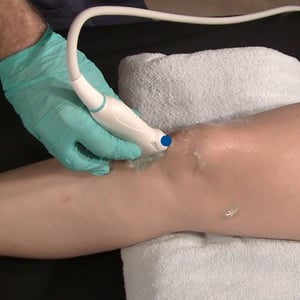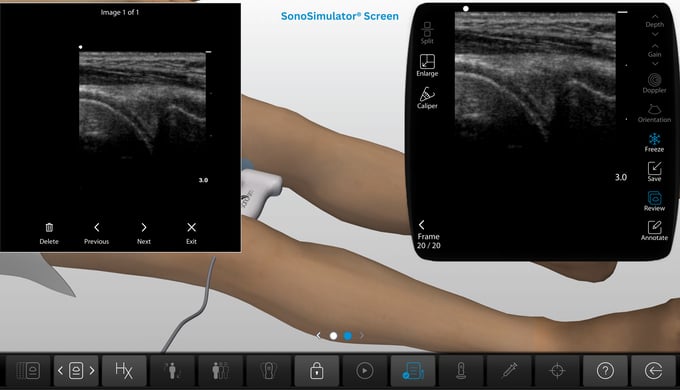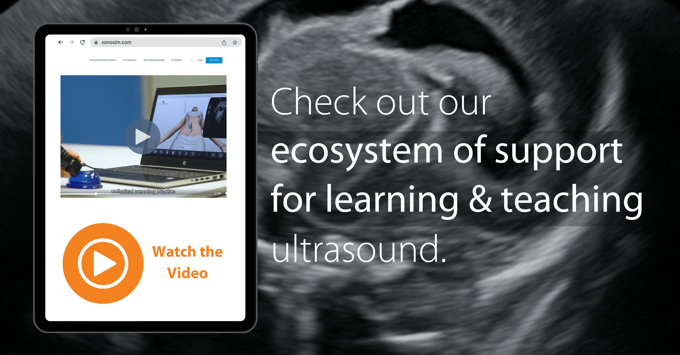🗞️ Ultrasound Application News
Check out our latest blog post where we explore how point-of-care ultrasound (POCUS) is used in the emergency department in this case study of a 52-year-old man presenting with severe knee pain. This case highlights the importance of musculoskeletal POCUS in improving diagnostic accuracy and patient outcomes.
Did you know that this week is Healthcare Simulation Week? Take a look at another recent study, where the value of simulation-based ultrasound training using formalin-embalmed cadavers is highlighted. This innovative approach significantly improves medical students' confidence and competence in performing ultrasound-guided procedures, such as cyst drainage, before working with live patients. Read the blog post to learn how simulation training enhances point-of-care ultrasound skills.
📚 Case Study: 67-year-old Male Presents with Painful Ambulation and Swelling in Left Knee
Take a look at this ultrasound case study!
-1.gif?width=566&height=422&name=TSW%20-%20July%202024%20Media%20(1)-1.gif)
Background:
- 67-year-old male
- Presents with painful ambulation and swelling in his left knee
- Denies fever, erythema, or warmth along the knee
- Reports a history of long-distance running
This is a long-axis view of the suprapatellar region in the knee. This is the patella, and this is the quadriceps tendon. We see an abnormal amount of fluid in the suprapatellar recess of the joint, consistent with an effusion. It is splitting the suprapatellar and prefemoral fat pads, coming up to form this cul-de-sac. This joint effusion can also be seen right behind the quadriceps tendon. A small amount of fluid in the knee is normal, but this is an abnormal amount.
👩⚕️ Scanning & Imaging Tips: Tendons
Use a linear array, high-frequency transducer to evaluate tendons. Align the transducer perpendicular to the tendon and identify the fibrillar, hyperechoic tendon in the long axis. Observe the range of motion, then rotate the transducer to image in the short axis. Anechoic fluid may indicate tendon injury. If a hypoechoic area disappears with beam angle adjustment, it's an anisotropic artifact; if not, it likely indicates a partial tear.

🔎 Scan & Seek - Fun with Physics
Keep watching below to see what the unusual subject we scanned this month was!
.gif?width=680&height=507&name=TSW%20-%20September%202024%20Media%20(4).gif)
Check out this amazing ultrasound of a frog underwater! Frogs, just like us, have lungs – but what’s cool here is how ultrasound reveals gas in those lungs! When sound waves encounter gas, they are scattered, and the resultant image is difficult to process or interpret meaningfully. The appearance of gas and the resulting artifacts are determined by gas location and volume and gas-bubble structure. Gas commonly results in "dirty shadowing", which is an attenuation-type artifact.
Instead of passing through the tissue, the sound waves bounce back, creating an interesting fuzzy/dirty effect on the image.
No amphibians were harmed in the making of this case study. 🐸
🧠 Challenge Case of the Month: MSK
Case History: This 35-year-old male presents to the Emergency Department with decreased range of motion of his left shoulder following a bicycle accident. Please evaluate the left posterior glenohumeral joint with ultrasound.
See the findings video below. 👇

Left Posterior Glenohumeral Joint (Pre-Reduction): Left posterior shoulder dislocation; Humeral head is posteriorly displaced and appears closer to the ultrasound transducer (near-field) on the image display screen; Deformity of the anteromedial humeral head likely represents a reverse Hill-Sachs lesion.
🔑 SonoSim Members: Don't forget that you have hundreds of Challenge Cases and that you get regular additions. Check them out in the SonoSimulator Case Library!
💥 SonoSim Updates
We're excited to announce SonoSim's latest updates! Read the full release notes for more details.
NEW Ultrasound-Guided Knee Joint Injection & Aspiration Training
- Learn the basic principles of performing ultrasound-guided knee joint injections and aspirations.
Review relevant anatomical landmarks and use ultrasound to evaluate the knee for underlying pathological conditions.
- Key topics covered include Regional Anatomy, Sonographic Anatomy, Transducer Selection & Patient Positioning, Survey Scan & Procedure Steps, Case Studies, Tips, Pitfalls, & Complications.
- Features real pathologic case with a variety of arthrocentesis approaches and techniques including: in-plane and out-of-plane needle guidance, suprapatellar lateral-to-medial approach, lateral parapatellar recess lateral-to-medial approach, medial parapatellar recess medial-to-lateral approach, and color Doppler evaluation.
💡 SonoSim Tips & Tricks
 Let's talk about reviewing & deleting images in the SonoSimulator®. After taking images by hitting "Freeze" and then "Save", you can then click the "Review" button. This will launch your saved image review feature in the upper left side of your SonoSimulator home screen (shown below). You can toggle through saved ultrasound images and keep or delete reviewed images. You can page through them to see your work and delete the ones you don't want to keep.
Let's talk about reviewing & deleting images in the SonoSimulator®. After taking images by hitting "Freeze" and then "Save", you can then click the "Review" button. This will launch your saved image review feature in the upper left side of your SonoSimulator home screen (shown below). You can toggle through saved ultrasound images and keep or delete reviewed images. You can page through them to see your work and delete the ones you don't want to keep.
Read the help article to learn more.

😂 LOLtrasound

Credit: Disney
📲 Follow Us on Social!

